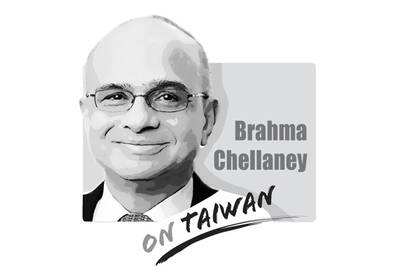Last week, Taishin Financial Holding Co and the Ministry of Finance announced that they had settled a dispute over state-run Chang Hwa Commercial Bank’s management rights, with Taishin Financial withdrawing its Supreme Court case against the ministry. Taishin Financial also sold 1.048 billion Chang Hwa Bank shares to other financial institutions for NT$19.09 billion (US$636.97 million), or NT$18.2 per share, in a block trade, the company said in a regulatory filing. The agreement ended a 17-year dispute, but at great cost.
In 2005, Taishin Financial outbid six competitors to purchase Chang Hwa Bank’s 1.4 billion special shares for NT$36.57 billion, or NT$26.12 per share. The deal gave it a controlling 22.5 percent stake in then-debt-ridden Chang Hwa, making it the bank’s largest shareholder. The ministry was the second-largest shareholder with a roughly 20 percent stake. Ideally, the deal should have had synergic benefits, as the state-run lender had a solid foothold in corporate lending and Taishin Financial’s banking arm, Taishin International Bank, had expertise in consumer banking, fixed income and wealth management.
However, this supposedly ideal match was never to be; Taishin Financial and the ministry have never been at peace with one another regarding the makeup of Chang Hwa’s nine-member board or with Taishin Financial’s plan to merge Chang Hwa with Taishin International Bank. Instead, boardroom showdowns between the two in 2014, 2017 and 2020 indicated they were simply not on the same page, with the tensions spilling over from one board election to the next.
This high-profile deal has revealed the fragility of public-private partnerships in the financial sector: Following the change of political power in Taiwan in 2008, the ministry withdrew its support for Taishin Financial to secure a board majority and control of Chang Hwa. It also highlights the government’s failure to observe the principles of good corporate governance, with its breach of contract harming the nation’s reputation in global capital markets.
The lengthy litigation also hurt Taishin Financial’s business development, causing it to miss an opportunity to expand its financial profile at a time when several other financial holding companies, such as Cathay Financial Holding Co, Fubon Financial Holding Co and CTBC Financial Holding Co, grew through mergers and acquisitions.
Perhaps seeing that the case had reached a point where it could not be dragged out any longer, Taishin Financial in 2020 announced that it would sell Chang Hwa shares to fund its NT$5.5 billion acquisition of Prudential Life Insurance Co of Taiwan. The company last year also pledged to the Financial Supervisory Commission that it would sell its Chang Hwa shares within six years and would not nominate new board members or exercise its voting rights in the state-run bank’s board elections as long as the commission approved its bid for Prudential’s local unit.
It is welcome news that the ministry and Taishin Financial, with the arbitration of Supreme Court judges over the past year, have finally reached a satisfactory consensus. The court said in a news release last week that the settlement was a win-win for both sides and was a successful example of the court’s mediation mechanism.
However, how many years can a company be expected to squander on a single deal? How does this saga affect people’s perception of the government? This win-win actually has a price for all.

China badly misread Japan. It sought to intimidate Tokyo into silence on Taiwan. Instead, it has achieved the opposite by hardening Japanese resolve. By trying to bludgeon a major power like Japan into accepting its “red lines” — above all on Taiwan — China laid bare the raw coercive logic of compellence now driving its foreign policy toward Asian states. From the Taiwan Strait and the East and South China Seas to the Himalayan frontier, Beijing has increasingly relied on economic warfare, diplomatic intimidation and military pressure to bend neighbors to its will. Confident in its growing power, China appeared to believe
Taiwan-India relations appear to have been put on the back burner this year, including on Taiwan’s side. Geopolitical pressures have compelled both countries to recalibrate their priorities, even as their core security challenges remain unchanged. However, what is striking is the visible decline in the attention India once received from Taiwan. The absence of the annual Diwali celebrations for the Indian community and the lack of a commemoration marking the 30-year anniversary of the representative offices, the India Taipei Association and the Taipei Economic and Cultural Center, speak volumes and raise serious questions about whether Taiwan still has a coherent India
Recent media reports have again warned that traditional Chinese medicine pharmacies are disappearing and might vanish altogether within the next 15 years. Yet viewed through the broader lens of social and economic change, the rise and fall — or transformation — of industries is rarely the result of a single factor, nor is it inherently negative. Taiwan itself offers a clear parallel. Once renowned globally for manufacturing, it is now best known for its high-tech industries. Along the way, some businesses successfully transformed, while others disappeared. These shifts, painful as they might be for those directly affected, have not necessarily harmed society
Legislators of the opposition parties, consisting of the Chinese Nationalist Party (KMT) and the Taiwan People’s Party (TPP), on Friday moved to initiate impeachment proceedings against President William Lai (賴清德). They accused Lai of undermining the nation’s constitutional order and democracy. For anyone who has been paying attention to the actions of the KMT and the TPP in the legislature since they gained a combined majority in February last year, pushing through constitutionally dubious legislation, defunding the Control Yuan and ensuring that the Constitutional Court is unable to operate properly, such an accusation borders the absurd. That they are basing this